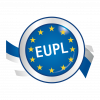There is consensus that the EUPL is “copyleft”. Many current comments speak more of a "share alike - reciprocal" license. A German lawyer speaks of an “interoperable copyleft” license. What exactly is it?
On the choice of terms, during a 2023 OSOR workshop, representatives of open source communities from Member States acknowledged that the public, including most copyright-holding managers, still did not understand what exactly this term meant. Thirty years after the word appeared, it is worrying. This is probably why Creative Commons uses "share alike" (distributed derivatives must be provided under the same license) and more and more authors use "reciprocal" (source code of distributed contributions is provided back to the community), which looks more understandable. However, the text of the current EUPL license (v1.2) still includes a "copyleft clause" (in its article 5), which has embarrassed some translators, since the license has a working value in 23 languages.
So, since “copyleft” is still the word used, what does it mean in the EUPL context?
1) That copies and derivative works must remain under the same license (the "share alike" condition). This is for avoiding exclusive appropriation of these derivatives. But European law allows interoperability, by copying without having to ask permission, of the necessary interfaces (APIs, data structures, etc.). Therefore an independent program linked (statically or dynamically) is not part of a combined derivative work. Each component is licensed separately, even if the end-user perceives a unique program. On this point, we can undoubtedly say that the EUPL functions like the LGPL; it is not a "viral" license.
2) That as an exception to point 1, you can copy part, or even all of the covered source code into another program which has been distributed under a compatible license (the list of which is given in the annex to the EUPL). No one will relicense the original. But concerning the derivatives, as this list includes the GPL-2, GPL-3, AGPL, but also the LGPL, EPL or MPL which have a more moderate copyleft ("weaker copyleft"), analysts have concluded that for these derivatives, the copyleft of the EUPL was “variable”.
3) However, don’t forget the text of the EUPL: “Should the Licensee’s obligations under the Compatible License conflict with his/her obligations under this (EUPL) License, the obligations of the Compatible License shall prevail”. So there is double coverage, managing license conflicts and giving priority to the compatible license in such cases. But as none of the compatible licenses come into conflict with the EUPL by prohibiting the essential points of publication of the source code and coverage of remote distribution (closing the SaaS loophole), these obligations, that are the core of the "reciprocal" condition, persist for the derivatives concerned.
The combination of these three points provides the specific copyleft of the EUPL.
Any suggestions for achieving greater clarity will be welcome!

